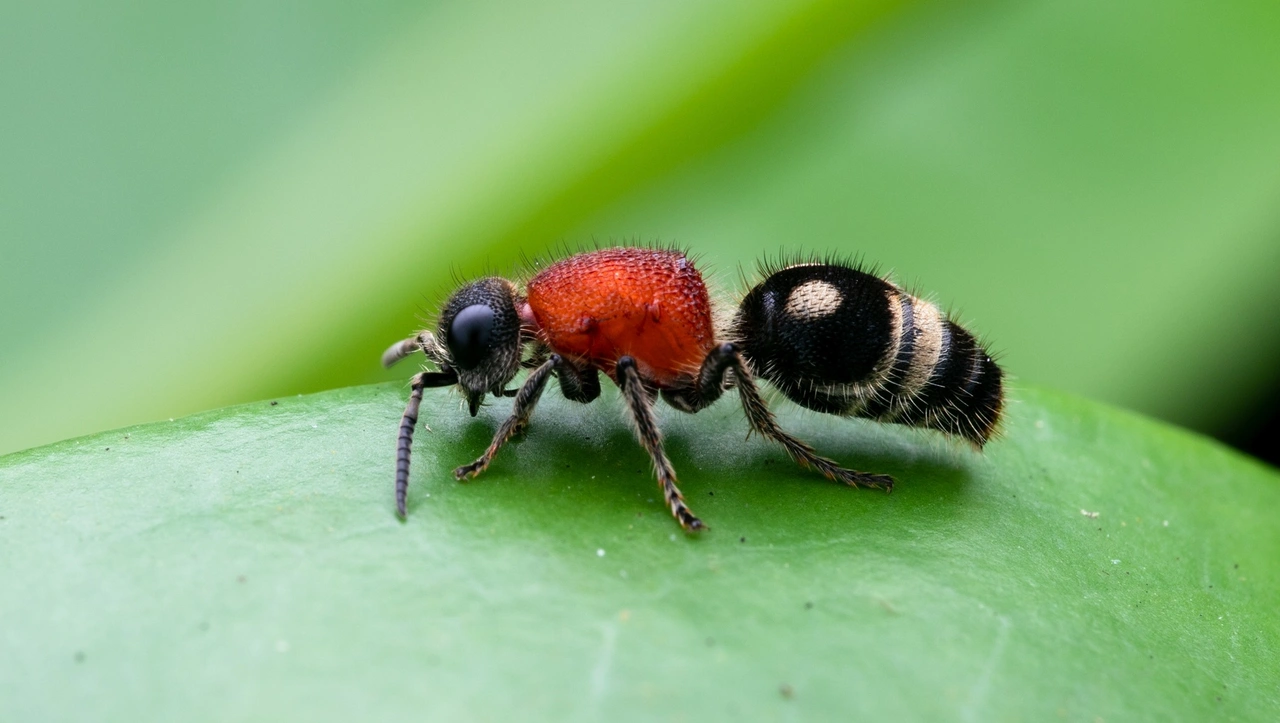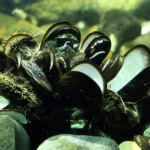
Welcome to our exploration of one of nature’s most fascinating creatures: the velvet ant! Despite their name, these intriguing insects are actually a type of wasp and are known for their striking appearance and unique behaviors. In this blog post, we will delve into 25 interesting facts about velvet ants that will not only pique your curiosity but also deepen your appreciation for the diversity of life on our planet. From their vibrant colors to their remarkable survival strategies, velvet ants are truly captivating. So, let’s uncover the secrets of these remarkable insects and discover what makes them stand out in the animal kingdom!
Not True Ants: Velvet ants, despite their common name, are not true ants but are actually a type of wasp belonging to the family Mutillidae. The females are characterized by their wingless bodies, which gives them an ant-like appearance. This resemblance is a result of evolutionary adaptation, allowing them to blend in with their surroundings and escape predators. Males, on the other hand, are equipped with wings and can fly, providing them with a different set of survival strategies. The confusion surrounding their classification highlights the diversity within the insect world and the importance of understanding the distinctions between different species.
Bright Coloration: Velvet ants are notable for their strikingly bright coloration, which can range from vibrant red and orange to deep yellow. This coloration is not just for show; it serves a critical purpose in the animal kingdom known as aposematism. By advertising their bright colors, velvet ants signal to potential predators that they possess a painful sting, which discourages attacks. The velvety texture of their fur adds to this warning, making them easily recognizable in their habitats. This evolutionary trait is a fascinating example of how species adapt to survive in the wild.
Painful Sting: The sting of female velvet ants is infamous for its intensity, earning them the nickname “cow killer.” This moniker is somewhat exaggerated, as the sting is unlikely to be fatal to a cow, but it is indeed one of the most painful insect stings documented. The pain has been rated a 3 on the Schmidt Pain Index, a scale developed by entomologist Justin Schmidt to quantify the pain caused by insect stings. The sting serves as a defense mechanism, deterring predators and ensuring the survival of these insects. Those who have experienced the sting often describe it as a sharp, burning sensation that can last for several hours.
Sting Intensity: Velvet ants are ranked 3 on the Schmidt Pain Index, which categorizes insect stings based on their painfulness. The index ranges from 1 to 4, with 1 being the least painful (like that of a fire ant) and 4 being excruciating (like that of a bullet ant). The sting of a velvet ant is described as a sharp, intense pain that can leave a lingering sensation. This high ranking underscores the effectiveness of their sting as a deterrent against potential threats. The pain is not only a defensive mechanism but also plays a role in their mating behaviors, as it can affect the interactions between males and females.
No Wings (Females): Female velvet ants are unique in that they are completely wingless, which differentiates them from many other wasp species. This absence of wings allows them to inhabit specific ecological niches where flight may not be necessary or advantageous. Instead, they rely on their speed and agility on the ground to evade predators and search for suitable locations to lay their eggs. The wingless condition of females is an evolutionary adaptation that enhances their survival in environments where they can blend in with the ground or foliage, further aiding in their mimicry of ants.
Global Distribution: Velvet ants are widely distributed across the globe, with over 3,000 species identified in various habitats, from deserts to forests. This extensive range reflects their adaptability to different environments and climates. They are found on every continent except Antarctica, showcasing their resilience and ecological versatility. The diversity of species within the Mutillidae family means that velvet ants can exhibit varying behaviors and adaptations depending on their specific habitats, making them a fascinating subject of study for entomologists and ecologists alike.
Parasitic Larvae: The larvae of velvet ants are known to be parasitoids, meaning they develop by feeding on the larvae of other insects, particularly bees and wasps. This parasitic behavior is a crucial part of their life cycle, allowing them to exploit the resources of other species. Female velvet ants typically lay their eggs in or near the nests of host insects, ensuring that the larvae have access to a food source upon hatching. This relationship highlights the complex interactions within ecosystems and the various strategies that species employ to survive and reproduce.
Tough Exoskeleton: Velvet ants possess an incredibly tough exoskeleton, which serves multiple purposes. This hard outer layer not only provides protection against physical threats but also helps prevent desiccation in their often-arid habitats. The durability of their exoskeleton makes them difficult to crush, deterring potential predators. Additionally, this robust structure allows them to endure harsh environmental conditions, contributing to their survival and adaptability. The toughness of their exoskeleton is a remarkable evolutionary trait that enhances their resilience.
Fast Runners: Female velvet ants are among the fastest-running insects, capable of reaching speeds of up to 0.5 meters per second. This remarkable speed is essential for their survival, as it allows them to evade predators and navigate their environments effectively. Their agility is particularly advantageous given their wingless condition, as they must rely on quick movements to escape threats. This speed is complemented by their ability to blend in with their surroundings, making them elusive targets. The combination of rapid movement and camouflage contributes to their success as both foragers and survivors in various habitats, showcasing the fascinating adaptations insects can develop.
No Nests: Unlike many other social insects, velvet ants do not construct their own nests. Instead, female velvet ants lay their eggs in the nests of other insects, particularly those of bees and wasps. This behavior is a form of parasitism, as the larvae will consume the host larvae or their food supply once they hatch. The absence of nest-building behavior allows velvet ants to conserve energy and resources, relying on the existing structures of other species for reproduction. This unique reproductive strategy highlights the intricate relationships that can exist between different insect species and the various survival tactics they employ in nature.
Mimicry: Some species of velvet ants exhibit mimicry, where they imitate the appearance of other stinging insects, such as bees and wasps. This adaptation serves as a defense mechanism, as it can confuse potential predators and deter them from attacking. By resembling more dangerous insects, velvet ants can avoid predation without having to rely solely on their painful sting. This evolutionary strategy highlights the intricate relationships between species in ecosystems, as well as the role of visual cues in predator-prey interactions.
Longevity: Adult velvet ants can live for up to a year, which is relatively long for many insects. This lifespan allows them to take advantage of seasonal resources and reproductive opportunities. The longevity of velvet ants is particularly beneficial for females, as it provides them with ample time to find suitable hosts for their eggs and ensure the survival of their offspring. Their extended lifespan also allows them to adapt to changing environmental conditions, contributing to their overall success as a species.
Nocturnal Activity: Many species of velvet ants are nocturnal, meaning they are primarily active at night. This behavior reduces their risk of predation from daytime hunters and allows them to exploit resources that may be less available during daylight hours. Nocturnal activity can also help them avoid competition with other insects that are active during the day. The adaptation to a nocturnal lifestyle showcases the diverse strategies insects use to survive and thrive in various ecological niches.
Chemical Defense: Velvet ants produce defensive chemicals that deter predators, adding another layer of protection beyond their painful sting. These chemicals can be secreted from their bodies and may have unpleasant tastes or odors that discourage potential threats from attacking. This chemical defense mechanism is an important survival strategy, allowing velvet ants to coexist with various predators in their habitats. The ability to produce such chemicals illustrates the complex adaptations that insects have developed in response to predation pressure.
Mating Behavior: Mating behavior in velvet ants is fascinating and involves chemical communication. Males locate females by detecting pheromones released by the females, which serve as signals indicating their readiness to mate. This reliance on chemical cues is crucial for successful reproduction, as it allows males to find females even in dense vegetation or low visibility conditions. The use of pheromones highlights the importance of chemical communication in the insect world, as it plays a vital role in mating success and species propagation.
Egg Laying: Female velvet ants exhibit specific behaviors when laying their eggs, typically placing them near or inside the larvae of host insects. This strategic choice ensures that the newly hatched larvae have immediate access to a food source, as they will consume the host larvae or their provisions. The egg-laying process is critical for the survival of the velvet ant species, as it directly influences the success of their offspring. This reproductive strategy emphasizes the parasitic nature of velvet ants and their adaptations for survival.
Host Specificity: Some species of velvet ants are highly specialized and target specific host species for their reproductive needs. This host specificity can be advantageous, as it allows velvet ants to optimize their reproductive success by ensuring that their larvae have access to the most suitable food sources. However, this specialization also makes them vulnerable to changes in the populations of their host species, illustrating the delicate balance within ecosystems. The relationship between velvet ants and their hosts is a key aspect of their life cycle and ecological role.
Larval Development: Velvet ant larvae undergo a unique development process as they consume the host larvae before pupating. This parasitic behavior not only provides the necessary nutrition for their growth but also ensures that they have a safe environment for development. The larvae typically feed on the host’s resources, which can include stored food or the host larvae themselves. This strategy highlights the complex interactions between species and the various survival tactics employed by velvet ants to ensure their continuation as a species.
Size Range: Velvet ants exhibit a wide size range, with some species measuring as small as 0.2 inches and others reaching lengths of up to 1 inch. This variation in size can be attributed to the diverse ecological niches they occupy, and the different adaptations required for survival in those environments. The size of velvet ants can also influence their predation risk and reproductive strategies, as larger individuals may have advantages in certain situations. This diversity in size underscores the complexity of the Mutillidae family and the evolutionary pressures that shape their characteristics.
Sound Production: When threatened, velvet ants can produce a distinctive squeaking sound by rubbing their body parts together, a behavior known as stridulation. This sound may serve as a warning to potential predators, signaling that they are not an easy target. The ability to produce sound adds another layer to their defense mechanisms, allowing velvet ants to communicate their presence in a way that can deter threats. This fascinating form of communication highlights the diverse strategies insects use to protect themselves in the wild.
Predator Avoidance: Velvet ants utilize bright coloration as a form of aposematism to warn potential predators of their painful sting. This strategy involves displaying vivid colors that signal danger, effectively deterring attacks from animals that may have learned to associate such colors with a negative experience. The combination of their striking appearance and the painful consequence of an encounter makes velvet ants less appealing to predators. This form of predator avoidance is a crucial survival tactic, allowing them to thrive in environments where they might otherwise be at risk.
Diet: Adult velvet ants primarily feed on nectar, which provides them with essential sugars and energy for their activities. This dietary preference allows them to play a role in pollination, as they visit various flowering plants while foraging for food. The larvae, however, are carnivorous and consume the larvae of their host insects, which is essential for their growth and development. This dual dietary strategy highlights the ecological versatility of velvet ants and their ability to occupy different niches throughout their life cycle.
Flightless Males: While most male velvet ants are winged and capable of flight, there are some species where males are also flightless, although this is relatively rare. This adaptation may be a response to specific environmental conditions or life history strategies. Flightless males rely on ground movement to locate females, which can affect their mating success and distribution. The existence of flightless males among velvet ants illustrates the diversity of adaptations within the family and how different species can evolve unique traits based on their ecological contexts.
Hibernation: Certain species of velvet ants exhibit hibernation behavior during the winter months to survive cold temperatures. By entering a state of dormancy, they can conserve energy and withstand harsh environmental conditions until warmer weather returns. This hibernation strategy is crucial for their survival, as it allows them to avoid the risks associated with extreme cold and food scarcity. The ability to hibernate highlights the adaptability of velvet ants to seasonal changes and their strategies for enduring challenging climates.
Scientific Study: Velvet ants are of significant interest to scientists due to their unique defensive mechanisms and parasitic behaviors. Researchers study these insects to gain insights into evolutionary biology, ecology, and the interactions between species. Their remarkable adaptations, such as their painful sting and chemical defenses, provide valuable information about survival strategies in the insect world. Additionally, the parasitic relationship between velvet ants and their host insects offers a fascinating glimpse into the complexities of ecological interactions. The ongoing study of velvet ants contributes to our understanding of biodiversity and the evolutionary processes that shape life on Earth.
FAQs about Velvet Ants
1. What are velvet ants, really?
Velvet ants aren’t ants at all! They’re actually wingless wasps in the family Mutillidae. The name “velvet ant” comes from their ant-like appearance and the dense, velvety fur that covers their bodies. This fur often comes in striking colors, like bright reds, oranges, yellows, and blacks, making them quite noticeable. While they resemble ants, several key features distinguish them. For example, they have a more robust body shape and, as mentioned, are technically wasps. Only the females are wingless; males have wings.
2. Where do velvet ants live?
Velvet ants are found in various habitats across North, Central, and South America, as well as parts of Asia and Africa. They prefer warm, dry environments like deserts, grasslands, and open woodlands. You’re most likely to encounter them in areas with sandy or loose soil, as this is where they often nest.
3. Are velvet ants dangerous? What about that “cow killer” nickname?
Yes, velvet ants, especially females, possess a potent defense mechanism: a very long and painful sting. The nickname “cow killer” comes from the (perhaps exaggerated) idea that the sting is so excruciating it could kill a cow. While likely an exaggeration, it speaks to the sting’s severity. The pain is described as intense and can last for several minutes or even hours. It’s often compared to a bee sting but significantly more painful. The sting is primarily used for defense against predators or if the velvet ant feels threatened. So, while not aggressive, they will readily sting if provoked.
4. Why are they so brightly colored? Is it a warning?
Absolutely! The bright colors of velvet ants serve as a warning signal, a phenomenon known as aposematism. It essentially tells potential predators, “Stay away! I’m dangerous.” The vibrant colors advertise the potent sting and discourage animals from trying to eat them. This is a very effective strategy, as predators quickly learn to associate the bright colors with a painful experience and avoid velvet ants in the future.
5. What do velvet ants eat?
Velvet ants are primarily parasitoids, meaning they live as parasites on other insects, particularly bees and wasps. The female velvet ant will typically enter the nest of a ground-nesting bee or wasp and lay her eggs on the developing larva or pupa. When the velvet ant larva hatches, it consumes the host larva or pupa, eventually pupating and emerging as an adult. Adult velvet ants are thought to feed on nectar, pollen, or other sugary substances.
6. What do male velvet ants look like? Why don’t they sting?
Male velvet ants are quite different in appearance from the females. They have wings, which they use for flight, and are generally smaller and less brightly colored than the females. Crucially, male velvet ants do not have a stinger. The stinger is a modified ovipositor (egg-laying tube) and is only present in females. Males may attempt to defend themselves by flying away or using their mandibles (jaws), but they lack the potent sting of the females.
7. What should I do if I see a velvet ant?
The best course of action is to admire it from a distance and leave it alone. Avoid handling velvet ants, even if they appear dead. They can still sting reflexively even after death. If you accidentally come into contact with one, avoid touching it with your bare hands. If you are stung, the best treatment is usually pain management. Over-the-counter pain relievers and cold compresses can help reduce the pain and swelling. In severe cases, it’s advisable to seek medical attention.
8. Are velvet ants beneficial?
While their sting is certainly not beneficial to humans, velvet ants play a role in the ecosystem as parasitoids. They help regulate populations of ground-nesting bees and wasps, which can sometimes become pests. However, their impact on these populations is usually not significant enough to be considered a major form of pest control.
9. Do velvet ants make any sounds?
Some velvet ant species are known to produce a squeaking or buzzing sound when threatened. This sound, produced by rubbing their body parts together, is thought to serve as an additional warning signal to predators.
10. How long do velvet ants live?
The lifespan of velvet ants is not well documented for all species. However, like other wasps, they likely go through a complete metamorphosis, from egg to larva to pupa to adult. The adult lifespan may vary depending on the species and environmental conditions.









